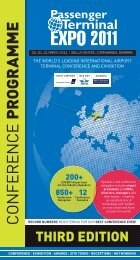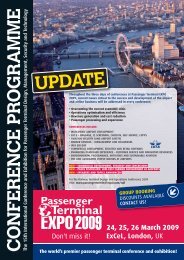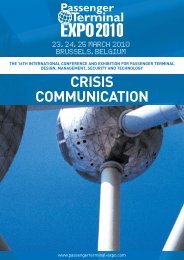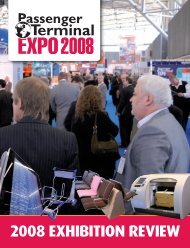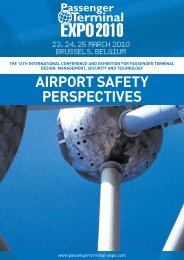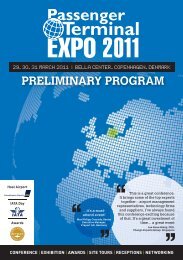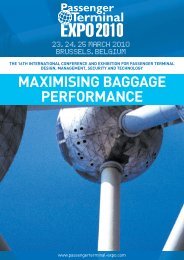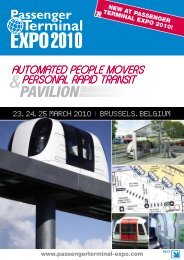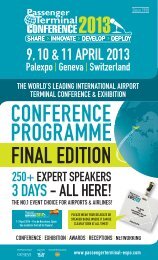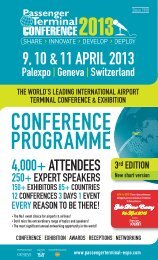and conference programme - Passenger Terminal Expo
and conference programme - Passenger Terminal Expo
and conference programme - Passenger Terminal Expo
Create successful ePaper yourself
Turn your PDF publications into a flip-book with our unique Google optimized e-Paper software.
09.40-10.05 Real-time biometrics for transactional identification applications<br />
– balancing security <strong>and</strong> convenience in airport operations<br />
Roberto Tavano, vice-president European security <strong>programme</strong>s, UNISYS<br />
Corporation, Belgium<br />
Fingerprint technology makes up well over 50% of the biometrics market today, due to low<br />
cost <strong>and</strong> existing large databases. Technology solutions should respond to the perceived<br />
needs of the end-users in the world biometrics market, <strong>and</strong> overcome five key barriers<br />
to the widespread deployment of biometric technology: 1) Accuracy; 2) Ease-of-use; 3)<br />
Person throughput; 4) Scalability; 5) Privacy protection. An analysis of operations at airports<br />
worldwide, including border control checks, helps underst<strong>and</strong> needs <strong>and</strong> opportunities in a<br />
critical environment where all five points contribute to the cost-effectiveness of the overall<br />
operation. High-throughput, scalable solutions are emerging, proposing a paradigm shift in<br />
airport practices.<br />
10.05-10.30 The future of border controls in the contradictory contexts of security<br />
<strong>and</strong> facilitation for travellers<br />
Elfa Ķere-Bāliņa, administrator - project lead, large scale IT systems,<br />
European Commission, Belgium<br />
This presentation begins by discussing the EU policy objective of integrated border<br />
management <strong>and</strong> the incorporation of new technologies for border control as part of the EU’s<br />
long-term IT strategy. The overarching goal is to merge existing instruments into a coherent<br />
strategy for the future, using biometrics to automate border crossings, enhancing security<br />
while facilitating bona fide travellers across our borders. EU initiatives include the possible<br />
development of an EU-wide biometrics-enabled entry/exit system <strong>and</strong> Registered Traveller<br />
<strong>programme</strong> for third-country nationals, as well as the use of automated gates for travellers<br />
holding e-passports.<br />
10.30-10.40 Questions <strong>and</strong> discussion with the audience<br />
10.40-11.00 Refreshment break<br />
11.00-11.25 Challenges <strong>and</strong> advances in border control – an integrator’s perspective<br />
Stephen Marley, ICIM chief architect, Raytheon, USA<br />
The role of an integrator is to translate business goals into reality in a way that satisfies<br />
the short-, medium- <strong>and</strong> long-term needs of all stakeholders. This presentation will discuss<br />
the particular challenges faced by a very diverse stakeholder community. We will discuss<br />
the needs <strong>and</strong> drivers of those stakeholders <strong>and</strong> the architectural principles that need to<br />
be considered when initiating a re-engineering border control process. We will also discuss<br />
techniques that have been used to successfully adhere to those principals.<br />
11.25-11.50 The French biometric passport<br />
Raphaël Bartolt, executive director, Agence Nationale des Titres Sécurisés<br />
- French Secure Documents Agency, France<br />
The presentation will examine the future French biometric passport, including developments<br />
<strong>and</strong> planning, <strong>and</strong> the new security aspects.<br />
11.50-12.15 Securing the border: developments in border control<br />
Ian Neill, deputy director, UK Border Agency, The Home Office, UK<br />
The vision of the e-Borders <strong>programme</strong> is to help create a safe <strong>and</strong> secure border for the 21st<br />
century. e-Borders will provide the capability to risk assess all passengers prior to arriving<br />
in <strong>and</strong> departing from the UK, <strong>and</strong> where necessary intervene against those considered to<br />
be high risk. In the interests of the UK’s people <strong>and</strong> economy, border agencies will be better<br />
informed <strong>and</strong> more effective in facilitating legitimate travel.<br />
www.pteme.com



